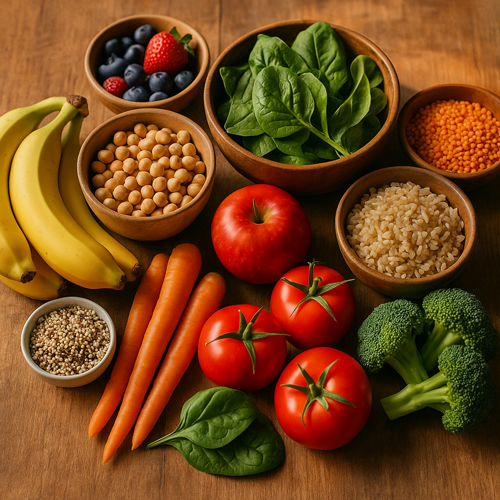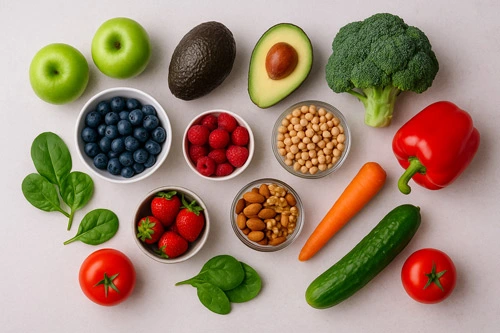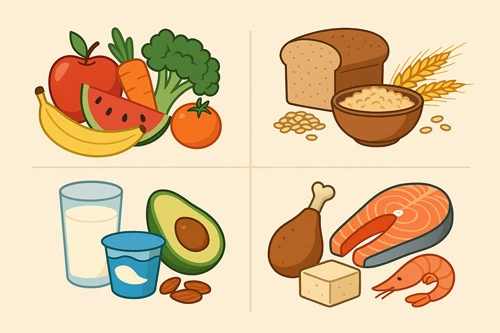The plant-based diet for beginners is a way of eating that emphasizes whole, natural foods derived primarily from plants. Unlike strict vegan diets that eliminate all animal products, a plant-based diet focuses on increasing the intake of fruits, vegetables, legumes, nuts, seeds, and whole grains, while minimizing or avoiding processed foods and animal-based products. It’s not necessarily about being 100% plant-exclusive, but rather about making plants the foundation of your meals.
This way of eating has gained significant popularity in recent years, especially among individuals looking to improve their overall health, lose weight, or reduce their environmental footprint. One of the main reasons for its rise is the growing body of scientific research linking plant-based eating to reduced risk of chronic diseases such as heart disease, diabetes, and certain types of cancer.
In addition to health benefits, the plant-based diet for beginners is also attractive due to its positive impact on the environment. Plant-based agriculture typically uses fewer natural resources and produces less greenhouse gas emissions than livestock farming. As more people become conscious of their food choices and their broader impact, the shift toward plant-based eating continues to grow.
2. Benefits of a Plant-Based Diet
Adopting a plant-based diet offers a wide range of benefits—not only for your personal health but also for the planet and the ethical choices you make in daily life. Let’s break down these benefits into three main categories:
2.1. Health Benefits
One of the biggest motivators for people transitioning to a plant-based diet for weight loss is its ability to promote better health naturally and sustainably. Research has shown that people who follow a plant-based diet tend to have lower body weight, reduced body fat, and improved metabolism. This is largely due to the high fiber content and low energy density of plant foods, which help you feel full while consuming fewer calories.
Beyond weight loss, plant-based eating supports heart health by reducing blood pressure, lowering LDL cholesterol (the “bad” cholesterol), and improving overall cardiovascular function. It also helps regulate blood sugar levels, making it a powerful tool in preventing or managing type 2 diabetes.
Additionally, high-fiber plant foods aid in digestion and gut health, promoting regular bowel movements and supporting a diverse microbiome.
2.2. Environmental Impact
The benefits of a plant-based diet extend beyond individual health. It also plays a significant role in environmental sustainability. Compared to diets high in animal products, plant-based eating results in significantly lower greenhouse gas emissions, water usage, and land consumption.
Producing plant foods generally requires fewer natural resources and contributes less to deforestation and pollution. As climate change becomes an urgent global issue, more people are turning to plant-based diets as a way to reduce their personal carbon footprint and contribute to a more sustainable food system.
2.3. Ethical & Lifestyle Considerations
For many individuals, switching to a plant-based diet is not just about health or the environment—it’s also an ethical lifestyle choice. Avoiding or reducing animal products aligns with the values of animal welfare, as it reduces demand for factory farming and industrial livestock operations that often involve inhumane treatment.
Additionally, a plant-based lifestyle encourages cleaner living by minimizing the intake of processed foods, hormones, and antibiotics commonly found in animal products. It fosters a deeper connection with food sources, mindful eating habits, and a more conscious approach to consumption.
3. What to Eat on a Plant-Based Diet
A common question from beginners is: What can you actually eat on a plant-based diet? The good news is that the variety is not only vast, but also flavorful, colorful, and highly nutritious. A plant based diet food list typically includes a wide range of whole, minimally processed plant foods that provide all the essential nutrients your body needs.
Below is a breakdown of the key food groups you’ll include in a healthy plant-based eating pattern:
3.1. Fruits
Fruits are a staple of the plant-based diet, offering natural sweetness, vitamins, antioxidants, and hydration. They can be enjoyed fresh, frozen, dried, or blended into smoothies. Popular options include:
-
Berries (blueberries, strawberries, raspberries)
-
Bananas
-
Apples
-
Oranges
-
Grapes
-
Mangoes
Fruits are ideal for snacks, breakfast toppings, or desserts.
3.2. Vegetables
Vegetables provide vital nutrients like fiber, potassium, vitamin C, and phytonutrients. Aim to eat a variety of colors and types daily:
-
Leafy greens: spinach, kale, arugula, romaine
-
Cruciferous veggies: broccoli, cauliflower, cabbage, Brussels sprouts
-
Root vegetables: sweet potatoes, carrots, beets
-
Nightshades: tomatoes, bell peppers, eggplant
-
Others: zucchini, cucumber, mushrooms
Cooked, raw, roasted, or steamed—they can be included in every meal.
3.3. Whole Grains
Whole grains are complex carbohydrates that provide energy and important B vitamins. Unlike refined grains, they retain their fiber and nutrients. Common examples include:
-
Brown rice
-
Quinoa
-
Oats
-
Barley
-
Buckwheat
-
Millet
-
Whole wheat bread and pasta (if minimally processed)
These form the base of many satisfying meals on a plant-based plan.
3.4. Legumes
Legumes are essential in a plant-based diet food list as they’re rich in protein, iron, and fiber. They help you feel full and fuel muscle growth:
-
Lentils (green, brown, red)
-
Chickpeas (great for hummus or roasted snacks)
-
Black beans
-
Kidney beans
-
Peas
-
Soybeans (edamame, tofu, tempeh)
Legumes are excellent in soups, salads, stews, and stir-fries.
3.5. Nuts and Seeds
Nuts and seeds are nutrient-dense, providing healthy fats, protein, and omega-3 fatty acids:
-
Almonds, walnuts, cashews
-
Chia seeds, flaxseeds, hemp seeds
-
Sunflower seeds, pumpkin seeds
-
Nut butters (peanut butter, almond butter)
While high in calories, they’re perfect for snacks or as toppings on oatmeal, salads, or smoothie bowls.
3.6. Plant-Based Oils and Fats (in moderation)
Though a whole-food plant-based diet emphasizes low oil intake, small amounts of healthy fats can be beneficial:
-
Extra virgin olive oil
-
Avocados
-
Coconut (unsweetened)
-
Tahini (sesame seed paste)
These contribute to heart health and meal satisfaction.
3.7. Herbs, Spices, and Flavor Enhancers
Flavor is key in any eating style! Plant-based meals can be incredibly tasty with the right seasonings:
-
Garlic, onion, ginger
-
Basil, cilantro, oregano, thyme
-
Cumin, turmeric, paprika, black pepper
-
Nutritional yeast (cheesy flavor & B12 source)
-
Vinegars, lemon juice, tamari, miso
These ingredients bring life to every dish, making plant-based eating enjoyable and never boring.
✅ Pro Tip:
Start by building your plate using the “Plant-Power Plate” model:
-
50% vegetables & fruits
-
25% whole grains
-
25% legumes & protein-rich foods
-
Add healthy fats, herbs, and spices to taste
Switching to a plant-based diet doesn’t just involve knowing what to eat—it also means being mindful of what to reduce or eliminate from your meals. While the level of strictness can vary depending on your personal goals and preferences, here are the main categories of foods to avoid or limit on a typical plant-based diet:
4. What to Avoid on a Plant-Based Diet
Switching to a plant-based diet doesn’t just involve knowing what to eat—it also means being mindful of what to reduce or eliminate from your meals. While the level of strictness can vary depending on your personal goals and preferences, here are the main categories of foods to avoid or limit on a typical plant-based diet:
4.1. Meat and Poultry
The cornerstone of a plant-based diet is avoiding animal flesh. This includes:
-
Red meat (beef, lamb, pork)
-
White meat (chicken, turkey)
-
Processed meats (bacon, sausages, deli meats)
These foods are high in saturated fat and cholesterol and are linked to an increased risk of heart disease and certain cancers. Plant-based alternatives such as lentils, tofu, and tempeh are excellent protein replacements.
4.2. Fish and Seafood
Although pescatarian diets include fish, a fully plant-based diet does not. Fish and seafood are excluded due to ethical, environmental, and health reasons—such as mercury content and overfishing concerns.
Instead, you can get omega-3 fatty acids from plant-based sources like flaxseeds, chia seeds, walnuts, and algae oil.
4.3. Dairy Products
Milk, cheese, butter, yogurt, and cream are all animal-derived and typically avoided. They can be replaced with plant-based alternatives:
-
Almond, soy, oat, or coconut milk
-
Vegan cheese (made from cashews or tofu)
-
Plant-based yogurts and creams
Avoiding dairy can help improve digestion, reduce inflammation, and clear up skin issues for many people.
4.4. Eggs
Eggs are often seen as a healthy protein source, but they’re excluded from a plant-based diet. You can substitute them with:
-
Tofu scramble (instead of scrambled eggs)
-
Flaxseed or chia egg (for baking)
-
Mashed banana or applesauce (for moisture in recipes)
These swaps are easy and nutrient-dense.
4.5. Processed Foods
Highly processed foods, even if plant-based, are best consumed in moderation or avoided entirely. These include:
-
Refined grains (white bread, white rice)
-
Sugary snacks, sodas
-
Packaged frozen meals with artificial ingredients
-
Deep-fried snacks
Even on a plant-based diet, the goal is to focus on whole, minimally processed foods for optimal health.
4.6. Added Sugars and Artificial Sweeteners
Many packaged foods contain added sugars or chemical sweeteners, which can negatively impact metabolism and energy levels. Check labels for:
-
High-fructose corn syrup
-
Aspartame
-
Sucralose
-
Other hidden sugars
Choose natural sweeteners like dates, maple syrup, or fruit instead.
4.7. Excess Salt and Oil
Although salt and oil are technically plant-derived, excessive intake of both can hinder the health benefits of your diet:
-
High sodium levels contribute to high blood pressure.
-
Excessive oil (especially refined oils) adds unnecessary calories.
Use herbs, spices, lemon juice, and a dash of sea salt to enhance flavor, and opt for steaming, baking, or grilling instead of frying.
🔁 Transition Tips for Beginners:
-
Go gradually: Start by replacing one meal a day with a plant-based option.
-
Read labels: Many “healthy” foods contain hidden animal products or additives.
-
Plan ahead: Meal prepping helps you avoid falling back on unhealthy processed foods.
Transitioning to a plant-based lifestyle doesn’t mean giving up flavor or satisfaction. In fact, one of the best ways to stay on track is by following a well-balanced plant based diet meal plan that ensures you’re getting all the essential nutrients while keeping meals exciting and enjoyable.
Here’s a one-day sample meal plan to give you a feel for what a typical day on a plant-based diet might look like:
5. Sample Plant-Based Diet Meal Plan
Transitioning to a plant-based lifestyle doesn’t mean giving up flavor or satisfaction. In fact, one of the best ways to stay on track is by following a well-balanced plant based diet meal plan that ensures you’re getting all the essential nutrients while keeping meals exciting and enjoyable.
Here’s a one-day sample meal plan to give you a feel for what a typical day on a plant-based diet might look like:
🥣 Breakfast: Overnight Oats with Berries and Chia Seeds
-
Rolled oats soaked overnight in almond milk
-
Topped with blueberries, banana slices, and chia seeds
-
Sweetened with a touch of maple syrup
-
Sprinkle of cinnamon for flavor
Benefits: High in fiber, antioxidants, omega-3s, and natural energy—perfect for starting your day strong.
🥗 Lunch: Rainbow Quinoa Salad
-
Cooked quinoa as a base
-
Mixed greens (spinach, kale)
-
Roasted chickpeas for protein
-
Bell peppers, cucumbers, cherry tomatoes, shredded carrots
-
Avocado slices
-
Dressing: olive oil, lemon juice, Dijon mustard, black pepper
Benefits: A colorful, protein-packed bowl that’s nutrient-dense and great for digestion.
🍎 Snack: Apple Slices with Almond Butter
-
One crisp apple sliced
-
Served with 1-2 tablespoons of unsweetened almond butter
Benefits: Healthy fats and fiber to keep you full and avoid energy crashes.
🍛 Dinner: Lentil and Sweet Potato Curry
-
Red lentils simmered with coconut milk, sweet potatoes, spinach, garlic, onions, and curry spices
-
Served over brown rice or with whole wheat roti
Benefits: A warm, comforting dish full of protein, iron, and complex carbs.
🍫 Optional Dessert: Dark Chocolate & Mixed Nuts
-
A small square of 70%+ dark chocolate
-
A handful of walnuts and dried cranberries
Benefits: Satisfies sweet cravings with antioxidants and healthy fats.
✅ Daily Nutrition Overview
-
Protein: Lentils, chickpeas, quinoa, almond butter
-
Carbs: Oats, fruits, sweet potato, brown rice
-
Fats: Avocado, olive oil, nuts, seeds
-
Fiber: All meals are fiber-rich for digestion and satiety
-
Hydration: Drink at least 6–8 glasses of water throughout the day
🌿 Pro Tips for Success:
-
Prep meals in batches to save time
-
Keep healthy snacks on hand (fruit, trail mix, hummus + veggies)
-
Use herbs and spices to elevate every dish
6. 30-Day Plant-Based Diet Plan
Adopting a new way of eating can feel overwhelming at first. That’s why following a 30-day plant-based diet plan is a powerful way to build new habits, discover favorite recipes, and transform your relationship with food—step by step.
This 4-week plan is designed to be flexible, nutritious, and beginner-friendly. Whether your goal is better health, sustainable weight loss, or more energy, this structured approach makes it easier to stay on track.
🗓️ Week 1: Clean Start & Transitioning
Focus: Removing animal products, adding more whole foods
Goals: Hydration, fiber intake, simple meals
Tips:
-
Replace dairy with plant-based milk
-
Prepare basic staples (rice, beans, veggies)
-
Try 2 new recipes this week
Sample Dinners:
-
Veggie stir-fry with tofu
-
Baked sweet potato with black beans
-
Chickpea salad sandwich
🗓️ Week 2: Nutrient Focus & Meal Diversity
Focus: Balancing macronutrients, trying new plant proteins
Goals: Increase protein, iron, and B12-rich foods
Tips:
-
Try quinoa, tempeh, or lentil pasta
-
Add dark leafy greens to at least one meal per day
-
Use nutritional yeast (B12) as a seasoning
Sample Dinners:
-
Lentil soup with whole grain bread
-
Vegan chili with avocado
-
Buddha bowl with roasted vegetables and tahini dressing
🗓️ Week 3: Flavor & Energy Boost
Focus: Experimenting with spices, global recipes
Goals: Enhance flavor, reduce cravings, improve gut health
Tips:
-
Use herbs like cilantro, basil, and cumin
-
Make homemade hummus or bean dips
-
Add fermented foods like kimchi or sauerkraut
Sample Dinners:
-
Thai peanut tofu with brown rice
-
Cauliflower tacos with avocado crema
-
Indian chickpea curry with basmati rice
🗓️ Week 4: Weight Loss & Lifestyle Integration
Focus: Fine-tuning meals, portion control, intuitive eating
Goals: Light dinners, mindful eating, stable energy
Tips:
-
Use smaller plates to avoid overeating
-
Snack on raw vegetables or fruit
-
Plan meals ahead of time to avoid temptation
Sample Dinners:
-
Zucchini noodles with lentil marinara
-
Stuffed bell peppers with quinoa and beans
-
Grilled veggie skewers with couscous
📌 Weekly Structure Guide
| Day | Breakfast | Lunch | Dinner | Snack |
|---|---|---|---|---|
| Monday | Green smoothie + chia seeds | Hummus wrap + fruit | Sweet potato curry | Almonds + dates |
| Tuesday | Oatmeal + berries | Quinoa bowl + avocado | Lentil stew | Rice cakes + almond butter |
| Wednesday | Scrambled tofu + toast | Chickpea salad + greens | Vegan chili | Apple slices + peanut butter |
| Thursday | Overnight oats + banana | Brown rice + stir-fried veggies | Tempeh tacos | Carrot sticks + hummus |
| Friday | Smoothie bowl | Pasta with marinara + spinach | Cauliflower steaks | Dark chocolate + walnuts |
| Saturday | Avocado toast + tomato | Black bean burger | Buddha bowl | Homemade granola + coconut |
| Sunday | Pancakes (vegan) + berries | Leftovers or meal prep | Roasted veggie soup | Trail mix |
💡 Additional Tips for Your 30-Day Plant-Based Journey:
-
Keep a food journal to track energy levels and digestion.
-
Drink herbal teas to support hydration and cravings.
-
Stay active with daily walking, yoga, or light exercise.
-
Involve family or friends to increase motivation.
By the end of this 30-day plant-based diet plan, many people experience better digestion, improved mood, weight loss, and more energy. It’s not just about food—it’s a lifestyle transformation.
7. Easy & Delicious Plant-Based Diet Recipes
One of the best parts of switching to a plant-based lifestyle is discovering just how delicious and satisfying plant foods can be. Whether you’re cooking for yourself, your family, or guests, these easy plant-based diet recipes prove that healthy eating doesn’t have to be boring or complicated.
🥣 1. Breakfast: Vegan Banana Oat Pancakes
Ingredients:
-
1 ripe banana
-
1 cup rolled oats
-
1/2 cup almond milk
-
1 tsp baking powder
-
1/2 tsp cinnamon
-
Optional: maple syrup, berries for topping
Instructions:
-
Blend all ingredients until smooth.
-
Heat a non-stick pan over medium heat.
-
Pour small rounds of batter and cook for 2–3 minutes per side.
-
Serve with fresh berries and a drizzle of maple syrup.
Why it works: High in fiber, naturally sweet, and perfect for a quick, energizing morning.
🥗 2. Lunch: Chickpea Avocado Salad Sandwich
Ingredients:
-
1 cup canned chickpeas (mashed)
-
1 ripe avocado
-
1 tbsp lemon juice
-
Salt & pepper to taste
-
Chopped celery, onion, and parsley
-
Whole grain bread or lettuce wraps
Instructions:
-
In a bowl, mash chickpeas and avocado together.
-
Mix in lemon juice, salt, and veggies.
-
Serve on toasted bread or wrapped in lettuce leaves.
Why it works: Protein-rich, creamy, and satisfying without any processed ingredients.
🍛 3. Dinner: Sweet Potato & Black Bean Tacos
Ingredients:
-
1 large sweet potato (cubed)
-
1 cup canned black beans
-
1/2 tsp cumin
-
1/2 tsp smoked paprika
-
Whole wheat or corn tortillas
-
Optional toppings: avocado, salsa, lime, cilantro
Instructions:
-
Roast sweet potato cubes with spices at 200°C (400°F) for 25 minutes.
-
Warm black beans in a pan.
-
Fill tortillas with sweet potato, beans, and toppings.
Why it works: A crowd-pleaser! It’s nutritious, filling, and full of flavor.
🍫 4. Dessert: Chocolate Chia Pudding
Ingredients:
-
2 tbsp chia seeds
-
1 cup almond milk
-
1 tbsp cocoa powder
-
1 tsp maple syrup
-
1/4 tsp vanilla extract
Instructions:
-
Mix all ingredients in a jar or bowl.
-
Refrigerate overnight or for at least 4 hours.
-
Stir before serving, and top with fruit or coconut flakes.
Why it works: A healthy, indulgent dessert packed with fiber and omega-3s.
✅ Pro Cooking Tips:
-
Always keep spices like garlic, cumin, turmeric, and smoked paprika on hand.
-
Invest in a good blender or food processor—great for smoothies, sauces, and dips.
-
Prep ingredients like quinoa, rice, and beans in bulk for the week.
-
Use nutritional yeast for a cheesy flavor and added B12.
8. Plant-Based Diet for Beginners: How to Get Started
Starting a plant-based diet for beginners can feel confusing at first—what to eat, what to avoid, and how to make it all work in real life. The good news is: it doesn’t have to be hard. With the right approach and mindset, transitioning to a plant-based lifestyle can be smooth, enjoyable, and deeply rewarding.
Here’s a simple step-by-step guide to help you get started:
✅ Step 1: Start Slow and Gradual
You don’t have to go 100% plant-based overnight. Begin by:
-
Replacing one meal per day with a plant-based option
-
Doing “Meatless Mondays”
-
Swapping cow’s milk for plant-based alternatives (almond, oat, soy)
-
Trying new fruits, vegetables, and plant proteins each week
Gradual change helps reduce stress and makes habits stick.
✅ Step 2: Learn the Basics of Plant-Based Nutrition
Make sure your meals include:
-
Complex carbs: whole grains, root vegetables
-
Plant proteins: legumes, tofu, tempeh, quinoa
-
Healthy fats: avocado, nuts, seeds
-
Fiber and antioxidants: from fruits and vegetables
Also, keep an eye on nutrients that may require attention like:
-
Vitamin B12 (consider supplements or fortified foods)
-
Iron (from lentils, spinach + vitamin C for better absorption)
-
Omega-3s (from flaxseeds, chia, walnuts)
✅ Step 3: Stock a Plant-Based Pantry
Fill your kitchen with staples that make cooking easier:
-
Dry goods: oats, brown rice, lentils, canned beans, quinoa
-
Spices and sauces: garlic, turmeric, soy sauce, tahini, balsamic vinegar
-
Plant-based milk and yogurt
-
Frozen fruits and vegetables (budget-friendly and convenient)
Having the right ingredients on hand prevents last-minute junk food choices.
✅ Step 4: Plan Your Meals Ahead
Meal planning saves time and money. Try:
-
Making a weekly meal plan
-
Batch-cooking grains, beans, and sauces
-
Prepping snacks like fruit, trail mix, or hummus + veggie sticks
-
Freezing portions for busy days
Start simple: build bowls with a grain, a protein, veggies, and a sauce.
✅ Step 5: Find Support and Inspiration
You’re not alone! Connect with:
-
Plant-based recipe blogs and YouTube channels
-
Social media communities and challenge groups
-
Cookbooks focused on plant-based diet for beginners
-
Local plant-based or vegan meetups (online or in-person)
Support makes the transition more fun and sustainable.
✅ Step 6: Be Patient and Kind to Yourself
You might slip up. That’s okay. Progress is better than perfection.
Remember:
-
You’re learning a new lifestyle
-
Every plant-based choice is a step forward
-
Your taste buds will adapt
-
Celebrate small wins like trying a new veggie or cooking your first plant-based meal
9. Plant-Based Diet for Weight Loss
🌿 Why the Plant-Based Diet Works for Weight Loss
Switching to a plant-based diet for weight loss is more than just eating more vegetables. It’s a powerful, science-backed approach that promotes fat loss while boosting overall health.
Here’s why it works:
-
Lower Calorie Density:
Plant-based foods are typically low in calories but high in volume and fiber. That means you can eat large, satisfying meals without consuming excess calories. -
High in Fiber:
Fiber slows digestion, helps regulate blood sugar, and keeps you feeling full longer—reducing cravings and overeating. -
Reduced Intake of Processed and Fatty Foods:
Most plant-based diets naturally limit high-calorie, high-fat processed foods, leading to a cleaner calorie profile. -
Improved Insulin Sensitivity:
Studies show plant-based diets help improve insulin response, which is key for fat loss and managing belly fat.
🍽️ Real-Life Meal Examples for Weight Loss
Here are sample plant-based diet for weight loss meals you can try:
-
Breakfast: Overnight oats with chia seeds, almond milk, banana, and berries
-
Lunch: Quinoa salad with chickpeas, cucumbers, cherry tomatoes, lemon-tahini dressing
-
Snack: Carrot sticks + hummus or a small apple with peanut butter
-
Dinner: Stir-fried vegetables with tofu over brown rice
-
Dessert: Baked apple with cinnamon and a sprinkle of oats
All high in nutrients, low in calories, and naturally fat-burning.
📉 Weight Loss Results from Research
Scientific studies have found that individuals on a plant-based diet:
-
Lose more weight than those on standard Western diets
-
Experience better long-term weight maintenance
-
See improvements in cholesterol, blood pressure, and inflammation markers
-
Have fewer food cravings over time
For example, a 16-week study published in Nutrition & Diabetes found participants on a plant-based diet lost nearly twice as much weight as those on a conventional diet.
💡 Tips for Success with Weight Loss on a Plant-Based Diet
-
Avoid high-calorie vegan junk food (e.g., vegan cookies, chips, fake meats)
-
Prioritize whole foods: fruits, vegetables, whole grains, legumes
-
Stay hydrated—sometimes thirst mimics hunger
-
Don’t skip meals—stable energy keeps metabolism active
-
Include regular movement: walking, yoga, strength training
10. Plant-Based Recipes and Meal Ideas
🍳 Breakfast Ideas
-
Vegan Overnight Oats
-
Ingredients: Rolled oats, almond milk, chia seeds, banana slices, and berries
-
Benefits: High fiber, easy prep, keeps you full for hours
-
Variation: Add cinnamon or cacao powder for extra flavor
-
-
Tofu Scramble with Veggies
-
Tofu + turmeric + mushrooms + spinach + bell pepper
-
A high-protein, low-fat alternative to scrambled eggs
-
-
Green Smoothie Bowl
-
Blend spinach, banana, plant milk, flaxseeds, and top with granola, berries, coconut flakes
-
🥗 Lunch Ideas
-
Quinoa & Chickpea Salad
-
Toss cooked quinoa, chickpeas, cucumber, tomato, parsley, olive oil, and lemon
-
Great for weight loss and full of protein and fiber
-
-
Lentil Soup with Whole Grain Bread
-
Rich in iron, filling, and comforting — ideal for winter days
-
-
Stuffed Sweet Potatoes
-
Bake sweet potatoes and fill them with black beans, corn, avocado, and salsa
-
A colorful and nutrient-packed lunch
-
🍛 Dinner Ideas
-
Vegetable Stir-Fry with Brown Rice
-
Sauté broccoli, carrots, zucchini, and tofu in tamari sauce
-
Balanced and satisfying
-
-
Chickpea Curry with Basmati Rice
-
Spicy, hearty, and comforting — perfect for batch cooking
-
-
Zucchini Noodles with Vegan Pesto
-
Great alternative to pasta, lower in carbs and perfect for a light dinner
-
🍪 Snacks & Sweets
-
Roasted Chickpeas
-
Crunchy, protein-rich, and portable
-
-
Fruit + Nut Butter
-
Apple slices with almond or peanut butter for sustained energy
-
-
Chia Pudding with Berries
-
High in omega-3s, fiber, and antioxidants — also makes a great dessert
-
📅 Sample 1-Day Plant-Based Meal Plan
-
Breakfast: Overnight oats with almond milk, chia seeds, and banana
-
Snack: Handful of almonds and an orange
-
Lunch: Lentil salad with spinach and balsamic dressing
-
Snack: Carrot sticks and hummus
-
Dinner: Stir-fried tofu with mixed veggies and brown rice
-
Dessert (optional): Chia pudding with cocoa powder
11. Plant-Based Diet and Weight Loss
The connection between a plant-based diet and effective weight loss is well-supported by scientific research. Eating predominantly whole, plant-derived foods naturally leads to reduced calorie intake, improved metabolism, and sustainable fat loss.
🌿 How a Plant-Based Diet Supports Weight Loss
-
Low Calorie Density: Plants like vegetables, fruits, and legumes provide large volumes of food with relatively few calories, helping you feel full while eating less.
-
High Fiber Content: Fiber slows digestion, balances blood sugar levels, and curbs hunger pangs.
-
Reduced Processed Food Intake: A plant-based diet limits processed, calorie-dense foods that often contribute to weight gain.
-
Improved Insulin Sensitivity: This enhances your body’s ability to burn fat effectively.
-
Better Gut Health: A fiber-rich diet promotes a healthy microbiome, which can influence weight management.
🍽️ Tips for Weight Loss Success on a Plant-Based Diet
-
Prioritize whole foods like vegetables, fruits, whole grains, and legumes.
-
Avoid or limit vegan junk foods, which can be high in calories and low in nutrients.
-
Stay well hydrated. Sometimes thirst is mistaken for hunger.
-
Don’t skip meals to keep metabolism steady.
-
Combine your diet with regular physical activity for best results.
📊 Research Insights
Studies consistently show that people following plant-based diets tend to lose more weight compared to those on conventional diets and maintain weight loss more effectively over time.






